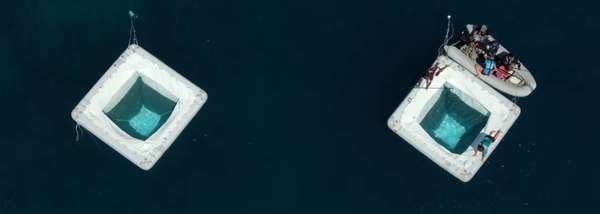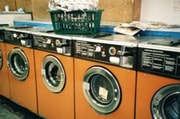Tourists and locals curious about floating inflatables in one Aussie beach
By
Danielle F.
- Replies 6
When talking about the deep Australian waters, many may think about the dangers looming in it.
Some may think of sharks, jellyfish, or the occasional rip current.
However, several visitors near the Great Barrier Reef were cautioned for a reason that's both surprising and inspiring.
The azure waters of Hook Island recently became the home to an innovative conservation effort that's both delicate and crucial to wildlife.
Tourists and locals alike were urged to tread these waters carefully.
Five inflatable pool-looking objects have been deployed off the beach, but these are not the average backyard kiddie pools.
The floating squares were part of a groundbreaking 'Coral IVF' program aimed at restoring the reef's vitality.
The Great Barrier Reef, a World Heritage-listed natural wonder, faced unprecedented challenges due to climate change.
Last year marked the worst summer on record for the reef due to coral bleaching.
In response, scientists and conservationists rolled up their sleeves to give Mother Nature a helping hand.
To ensure the operation's success, visitors should keep their distance from the inflatables.
The coral larvae are sensitive to chemicals found in sunscreen and fuel, so swimming or boating near the pools could jeopardise their survival.
During the annual full moon spawning event, which happens around October or November, coral species engage in a synchronised reproduction dance.
Through this event, corals release millions of eggs and sperm into the water.
The inflatable pools collect these 'coral babies' as they float to the surface.
The collected eggs and sperm are then nurtured within the pools, letting them develop away from threats of predators and ocean currents.
The Great Barrier Reef Foundation's Coral Restoration Director Melissa Rodgers explained that once the coral larvae are ready, they will be relocated onto the parts of the reef that need rejuvenation.
'When they're ready to settle, we will move to deployment, where we actually then—using a sort-of reverse vacuum cleaner — suck the larvae down onto an appropriate area of the reef where we want the larvae to settle,' Ms Rodgers shared.
In the wild, a coral larva has a one-in-a-million chance of finding the perfect spot to call home.
With this scientific intervention, the odds improve dramatically.
The Coral IVF program, now in its fourth year, has been a collaborative effort between the Australian Institute of Marine Science (AIMS), the Great Barrier Reef Foundation, and local tourism operators.
It's an example of how science can be used for the benefit of the environment.
By enhancing the resilience of the reef ecosystem, this initiative should be a proactive step in the face of climate change.
The program's recent expansion to Cairns and Port Douglas earlier this year marked a significant milestone.
Learn more about the Coral IVF program here:
Source: The Great Barrier Reef Foundation/YouTube
By involving local marine and tourist industries in the process, this initiative allows anyone relying on the reef to participate in its preservation.
So, on your next visit to the Great Barrier Reef, remember that the real magic is not just in the snorkelling or the sunsets—it's in the collective effort to protect and restore this irreplaceable ecosystem.

Have you visited the Great Barrier Reef recently, or are you planning to go anytime soon? We would love to hear your thoughts on this innovative conservation effort in the comments section!
Some may think of sharks, jellyfish, or the occasional rip current.
However, several visitors near the Great Barrier Reef were cautioned for a reason that's both surprising and inspiring.
The azure waters of Hook Island recently became the home to an innovative conservation effort that's both delicate and crucial to wildlife.
Tourists and locals alike were urged to tread these waters carefully.
Five inflatable pool-looking objects have been deployed off the beach, but these are not the average backyard kiddie pools.
The floating squares were part of a groundbreaking 'Coral IVF' program aimed at restoring the reef's vitality.
The Great Barrier Reef, a World Heritage-listed natural wonder, faced unprecedented challenges due to climate change.
Last year marked the worst summer on record for the reef due to coral bleaching.
In response, scientists and conservationists rolled up their sleeves to give Mother Nature a helping hand.
To ensure the operation's success, visitors should keep their distance from the inflatables.
The coral larvae are sensitive to chemicals found in sunscreen and fuel, so swimming or boating near the pools could jeopardise their survival.
During the annual full moon spawning event, which happens around October or November, coral species engage in a synchronised reproduction dance.
Through this event, corals release millions of eggs and sperm into the water.
The inflatable pools collect these 'coral babies' as they float to the surface.
The collected eggs and sperm are then nurtured within the pools, letting them develop away from threats of predators and ocean currents.
The Great Barrier Reef Foundation's Coral Restoration Director Melissa Rodgers explained that once the coral larvae are ready, they will be relocated onto the parts of the reef that need rejuvenation.
'When they're ready to settle, we will move to deployment, where we actually then—using a sort-of reverse vacuum cleaner — suck the larvae down onto an appropriate area of the reef where we want the larvae to settle,' Ms Rodgers shared.
In the wild, a coral larva has a one-in-a-million chance of finding the perfect spot to call home.
With this scientific intervention, the odds improve dramatically.
The Coral IVF program, now in its fourth year, has been a collaborative effort between the Australian Institute of Marine Science (AIMS), the Great Barrier Reef Foundation, and local tourism operators.
It's an example of how science can be used for the benefit of the environment.
By enhancing the resilience of the reef ecosystem, this initiative should be a proactive step in the face of climate change.
The program's recent expansion to Cairns and Port Douglas earlier this year marked a significant milestone.
Learn more about the Coral IVF program here:
Source: The Great Barrier Reef Foundation/YouTube
By involving local marine and tourist industries in the process, this initiative allows anyone relying on the reef to participate in its preservation.
So, on your next visit to the Great Barrier Reef, remember that the real magic is not just in the snorkelling or the sunsets—it's in the collective effort to protect and restore this irreplaceable ecosystem.
Key Takeaways
- Tourists and locals at Hook Island were warned to be careful around five inflatable pools deployed to collect 'coral babies'.
- The pools were part of a Coral IVF program designed to improve the odds of coral larvae settling in the Great Barrier Reef.
- The Great Barrier Reef Foundation emphasised the importance of this intervention, especially in light of the reef's recent significant bleaching events.
- The Coral IVF technique expanded its operations this year, with pools also launched in Cairns and Port Douglas and local tourism bodies being trained to aid the program.








